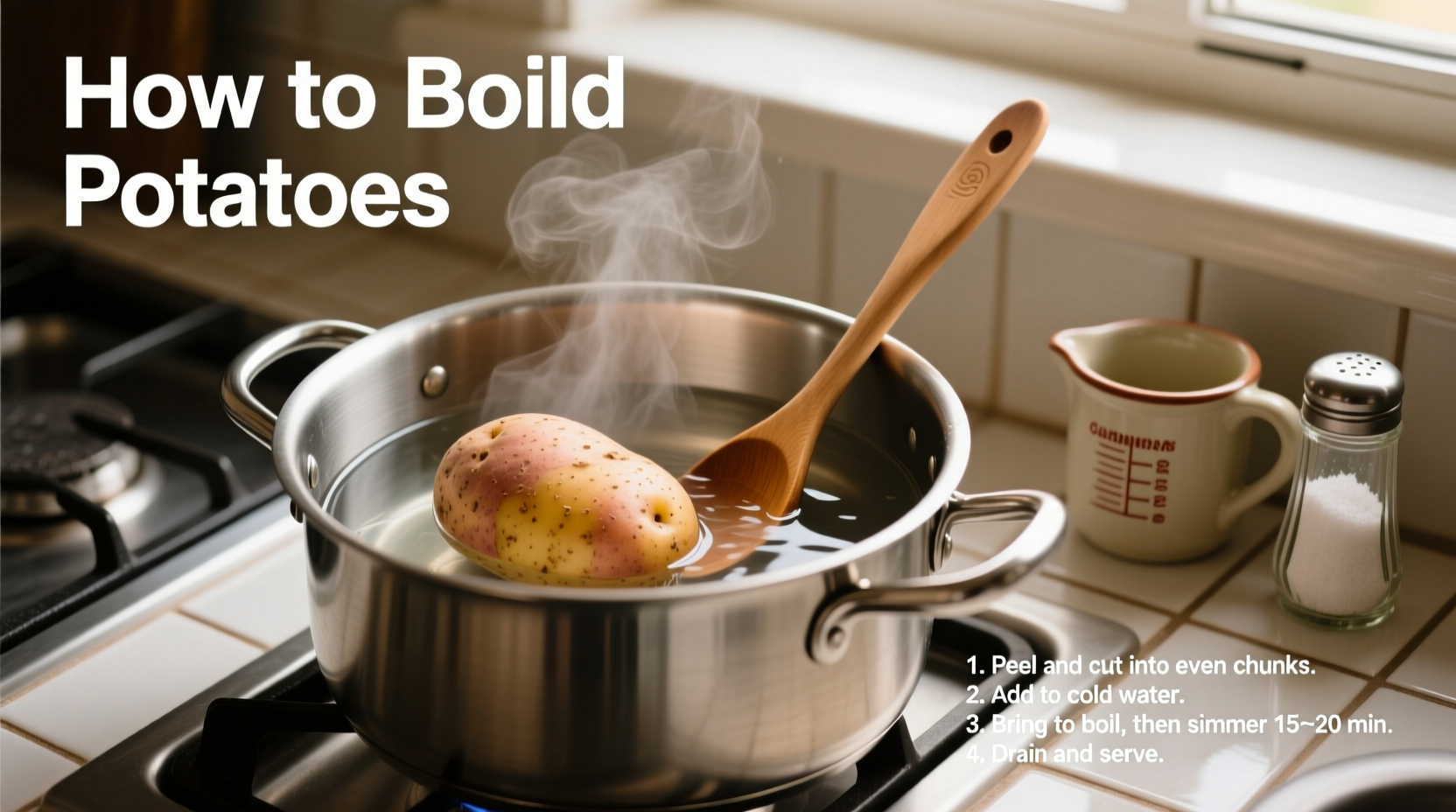The Science Behind Perfectly Boiled Potatoes
Many home cooks struggle with boiled potatoes that turn mushy, crack, or cook unevenly. The secret lies in understanding potato composition. Potatoes contain starch granules that absorb water when heated. According to USDA food safety guidelines, the ideal internal temperature for fully cooked potatoes is 210°F (99°C), but reaching this temperature requires careful technique to avoid texture issues.
Selecting the Right Potatoes
Not all potatoes behave the same when boiled. Understanding starch content is crucial:
| Potato Type | Starch Content | Best For | Boiling Time |
|---|---|---|---|
| Yukon Gold | Medium | All-purpose | 15-20 minutes |
| Red Bliss | Low | Salads | 20-25 minutes |
| Russet | High | Mashing | 25-30 minutes |
Professional chefs at the Culinary Institute of America recommend waxy potatoes for boiling as they maintain structure better. High-starch varieties like Russets work well for mashing but can become waterlogged if overcooked.
Preparation Techniques That Make a Difference
Proper preparation prevents common issues:
- Uniform sizing: Cut potatoes to 1.5-inch cubes for even cooking
- Cold water start: Prevents exterior overcooking while interior cooks through
- Salt timing: Add salt after water begins simmering to prevent surface starch gelation
Food science research from the USDA National Institute of Food and Agriculture shows that adding salt too early creates a barrier that slows water absorption, leading to uneven cooking. Wait until the water reaches a gentle simmer before adding 1 tablespoon of salt per quart of water.

Step-by-Step Boiling Process
Follow this professional method for consistently perfect results:
- Wash potatoes thoroughly under cold running water
- Peel if desired (skin-on retains more nutrients)
- Cut into uniform pieces using a sharp chef's knife
- Place in a large pot and cover with cold water by 1 inch
- Bring to a gentle simmer over medium heat (small bubbles at surface)
- Add salt once simmering begins
- Cook uncovered, stirring occasionally
- Test for doneness starting at 15 minutes
Testing for Perfect Doneness
Timing varies based on potato type and size. Use these reliable methods:
- Fork test: A fork should slide in with slight resistance
- Knife test: A paring knife should meet no resistance when inserted
- Squeeze test: Gently press between fingers (careful, hot!) - should yield slightly
Overcooking by just 2-3 minutes can turn potatoes mushy. The FDA Food Code recommends immediate draining once potatoes reach desired tenderness to stop the cooking process.
Post-Boiling Handling Tips
What you do after boiling affects the final texture:
- Drain immediately in a colander
- Return to empty pot over low heat for 1 minute to evaporate excess moisture
- For salads: Cool completely before mixing with dressing
- For mashing: Mash while hot with warm milk or cream
- For roasting: Toss with oil while slightly warm
Troubleshooting Common Problems
Solve these frequent boiling issues:
- Mushy potatoes: Overcooked or high-starch variety used improperly
- Cracked potatoes: Started in hot water causing rapid expansion
- Uneven cooking: Inconsistent sizing or overcrowded pot
- Dry potatoes: Undercooked or insufficient water during boiling
Remember that potatoes continue cooking from residual heat after draining. Remove them from water 1-2 minutes before they reach perfect tenderness.
Storage and Reheating Guidelines
Proper storage maintains texture for later use:
- Cool completely before refrigerating
- Store in airtight container for up to 4 days
- Reheat gently in microwave with damp paper towel
- For salads: Toss with dressing just before serving
Boiled potatoes lose quality after 4 days as starch retrogradation occurs. The USDA Agricultural Research Service confirms that reheating causes additional moisture loss, so add a splash of water when warming leftovers.
Frequently Asked Questions
How much salt should I add when boiling potatoes?
Use 1 tablespoon of salt per quart of water. Add the salt once the water reaches a gentle simmer, not at the beginning. This prevents the salt from creating a barrier that slows water absorption into the potatoes, which can lead to uneven cooking.
Should I peel potatoes before boiling?
Peeling is optional. Leaving skins on preserves nutrients and prevents waterlogging, but may create texture issues for mashing. If making potato salad, peeling after cooking is easier. For mashed potatoes, peel before boiling for smoother texture. Yukon Gold varieties often don't require peeling.
Why do my boiled potatoes fall apart?
Potatoes fall apart when high-starch varieties like Russets are overcooked or when started in hot water. Waxy potatoes hold shape better. To prevent disintegration, start potatoes in cold water, simmer gently (not boil vigorously), and test for doneness early. Cutting to uniform sizes also prevents some pieces from overcooking while others remain undercooked.
How can I prevent boiled potatoes from turning brown?
To prevent browning, place boiled potatoes in cold water immediately after cooking if not using right away. Adding a teaspoon of lemon juice or vinegar per quart of water creates an acidic environment that slows oxidation. For potato salad, mixing with dressing (which typically contains acid) right after cooling also prevents discoloration.











 浙公网安备
33010002000092号
浙公网安备
33010002000092号 浙B2-20120091-4
浙B2-20120091-4